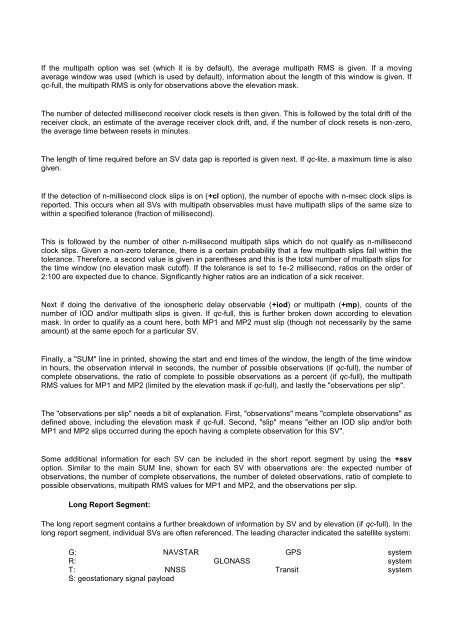Interpreting teqc's qc Mode Output Section 21. - Inpe
Interpreting teqc's qc Mode Output Section 21. - Inpe
Interpreting teqc's qc Mode Output Section 21. - Inpe
You also want an ePaper? Increase the reach of your titles
YUMPU automatically turns print PDFs into web optimized ePapers that Google loves.
If the multipath option was set (which it is by default), the average multipath RMS is given. If a movingaverage window was used (which is used by default), information about the length of this window is given. If<strong>qc</strong>-full, the multipath RMS is only for observations above the elevation mask.The number of detected millisecond receiver clock resets is then given. This is followed by the total drift of thereceiver clock, an estimate of the average receiver clock drift, and, if the number of clock resets is non-zero,the average time between resets in minutes.The length of time required before an SV data gap is reported is given next. If <strong>qc</strong>-lite, a maximum time is alsogiven.If the detection of n-millisecond clock slips is on (+cl option), the number of epochs with n-msec clock slips isreported. This occurs when all SVs with multipath observables must have multipath slips of the same size towithin a specified tolerance (fraction of millisecond).This is followed by the number of other n-millisecond multipath slips which do not qualify as n-millisecondclock slips. Given a non-zero tolerance, there is a certain probability that a few multipath slips fall within thetolerance. Therefore, a second value is given in parentheses and this is the total number of multipath slips forthe time window (no elevation mask cutoff). If the tolerance is set to 1e-2 millisecond, ratios on the order of2:100 are expected due to chance. Significantly higher ratios are an indication of a sick receiver.Next if doing the derivative of the ionospheric delay observable (+iod) or multipath (+mp), counts of thenumber of IOD and/or multipath slips is given. If <strong>qc</strong>-full, this is further broken down according to elevationmask. In order to qualify as a count here, both MP1 and MP2 must slip (though not necessarily by the sameamount) at the same epoch for a particular SV.Finally, a "SUM" line in printed, showing the start and end times of the window, the length of the time windowin hours, the observation interval in seconds, the number of possible observations (if <strong>qc</strong>-full), the number ofcomplete observations, the ratio of complete to possible observations as a percent (if <strong>qc</strong>-full), the multipathRMS values for MP1 and MP2 (limited by the elevation mask if <strong>qc</strong>-full), and lastly the "observations per slip".The "observations per slip" needs a bit of explanation. First, "observations" means "complete observations" asdefined above, including the elevation mask if <strong>qc</strong>-full. Second, "slip" means "either an IOD slip and/or bothMP1 and MP2 slips occurred during the epoch having a complete observation for this SV".Some additional information for each SV can be included in the short report segment by using the +ssvoption. Similar to the main SUM line, shown for each SV with observations are: the expected number ofobservations, the number of complete observations, the number of deleted observations, ratio of complete topossible observations, multipath RMS values for MP1 and MP2, and the observations per slip.Long Report Segment:The long report segment contains a further breakdown of information by SV and by elevation (if <strong>qc</strong>-full). In thelong report segment, individual SVs are often referenced. The leading character indicated the satellite system:G: NAVSTAR GPS systemR: GLONASS systemT: NNSS Transit systemS: geostationary signal payload
















